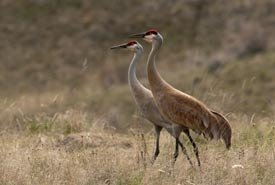Hydrology in the tall grass prairie

Sandhill cranes (Photo by Brendan Matthews)
In 2015, the Nature Conservancy of Canada's (NCC's) Manitoba Region initiated a multi-part project in partnership with Phil Gerla, hydrologist and associate professor at the University of North Dakota. The partnership aimed to explore how water moves in the Tall Grass Prairie Natural Area.
The project focused on the Roseau River and Vita Drain watersheds, which are separate but connected. The goals were:
- to gain a better understanding of the natural flow of water across the landscape;
- to restore natural water flow in places where it has been disrupted; and
- to improve conservation lands' abilities to retain water.
Keeping in mind the importance of activities such as grazing to local communities, this project also aimed to maintain the area's existing land management infrastructure.
The information gathered by the project will help inform the restoration of native species and habitats on NCC lands.
Pilot project
The first phase of the project involved a pilot restoration of the surface-water flow on an NCC property where the driveway has disrupted the natural patterns of this flow. It was important to keep the driveway infrastructure in place, as the property is used for grazing. To help move the water in a more natural way, drains were installed under the driveway. Low spots were filled with soil to prevent pooling. To help keep the water on the property, clay plugs were also installed in two spots along the ditch.
There has been much progress in the restoration of the site. The final stage will involve re-vegetating bare soil with native seeds. Staff will follow up with monitoring to determine the restoration's success.
Research and knowledge sharing
In the second phase of the project, professor Gerla examined how surface water moves across the landscape. He provided NCC staff with a tool to help better manage habitats within the Manitoba Tall Grass Prairie Natural Area.
In July, 2016, professor Gerla presented his research at the Weston Family Tall Grass Prairie Interpretive Centre. He discussed the methods used in his research, and outlined a number of water conservation opportunities on conservation land in the two watersheds. Participants were then invited on a field tour of various sites, including the pilot restoration.
Following the field tour, Gerla provided a hands-on session at the interpretive centre. Participants learned how to work with and analyze hydrological data sets. These hydrological data sets will allow NCC to identify and plan future restoration projects.
Testing the waters
Finally, to help engage the local community in water conservation efforts, NCC held a Conservation Volunteers event in August 2016. Volunteers worked with Melissa Grantham, an NCC assistant conservation biologist in Manitoba, and Dorthea Gregoire, Roseau Watershed technician with the Seine-Rat River Conservation District. Together, they gathered information on water quality, using water probes and water quality testing kits. Volunteers also learned about how different types of watering systems may impact water quality in dugouts. In addition to serving as a source of water for livestock, these dugouts often provide habitat for a variety of plants and animals.
Acknowledgement
The Nature Conservancy of Canada's Manitoba Region thanks the RBC Foundation for their support of our conservation efforts. Most recently, the RBC Foundation awarded NCC with a $100,000 Leadership Grant as a part of the 2015 RBC Blue Water Project, which is committed to protecting freshwater resources around the globe. Through this initiative, part of the funds went towards supporting this integral hydrology project.





